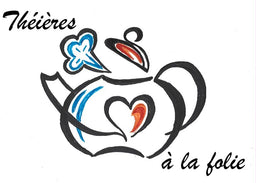Summary :
- All tea tastes better in clay teapots and the best teapots are made from a "purple clay" (Zisha) from the Yixing (Yee-zhing) region of China.
- Zisha clay has excellent porosity and heat resistance properties, which significantly improves the taste of tea compared to tea brewed in glass, porcelain or enameled teapots.
- A Yixing teapot should only be used for one type of tea.
- High temperature teapots with finer, thinner clay are excellent for any type of tea and are essential for green, white and Oolong teas. Low-temperature teapots, made with a thicker, more porous clay, are ideal for black tea (called red tea in China) and Pu-Erh tea. Chinese clay teapots are not glazed. The clay used remains porous and the tea oils are meant to accumulate inside the teapot and over time soften the taste of the tea and enhance it by adding its own unique "taste" due to accumulated oils. Different teas are not brewed in the same teapot unless they are from the same family or class of teas, such as different types of green or oolong teas, but even this is not ideal because some teas in the same family have a strong taste and, over time, can "contaminate" a more delicate tasting tea. Your teapot will be your friend for many years, so make sure it doesn't have any cracks or chips. It must have good weight and balance and be ergonomic in the hand. The lid should fit precisely into the opening, making it just large enough to accommodate the size of sheets you will be using. A smaller opening tends to keep the scent of the tea in the teapot while a larger opening tends to let the scent escape. Thus, teas with small or rolled leaves and very fragrant (green tea, white tea, Oolong tea) will benefit from a smaller opening. A larger opening is preferable for large leaf and weakly flavored teas (black teas and Pu-Erh). The spout should be wide enough to allow the tea to flow freely. Gong Fu Cha (the Chinese method of preparing tea) develops the taste of tea quickly with rapid steeping times. The spout hole must therefore be as wide as possible so as not to hinder the flow of the poured tea, which would lengthen the infusion times. Check other sized teapots to make sure the spout is proportional to the size of the teapot. Many newer teapots are equipped with a built-in filter. If your teapot is not equipped with a filter, ask for one to be inserted into the spout. Unlike Western pottery-making techniques where "earth clays" are turned on a wheel, the stiffer quality of Zisha clay allows the elements that will form a teapot to be made in advance. They will be assembled piece by piece.
There are 3 types of manufacturing: Handmade, semi-handmade and molded. The handmade teapots are shaped by an artist who cuts the pieces by hand and assembles them using traditional tools such as picks and wooden paddles. When preparing Zisha clay to make the different parts of a handmade teapot, it is folded many times. This folding strengthens the clay and creates micro-air pockets in the clay that allow air to flow back and forth through the teapot. This “double porosity” characteristic is reflected in the added oxygen to the tea during infusion and, as wine drinkers know, oxygen accentuates the taste. The term "semi-artisanal" refers to the act of assembling cast parts by hand with traditional tools. Many good Zisha clay teapots are made this way. Molded teapots are made by a mass production process of machine-assembling pre-molded parts, such as the two halves of the teapot and the lid, and attaching a pre-molded spout and handle. Although cast teapots are not as valuable as handmade or semi-handmade teapots, many are made with Yixing clay and are still superior to glazed or cast teapots. porcelain for making tea. Owning a handmade teapot is a great satisfaction especially if it was made by a famous artist.
Teapot making is a highly skilled art and some Zisha teapots by famous artists are collectibles and fetch very high prices, especially if they date from the 1980s or 1950s, or even the Qing dynasty (1644-1912). Antique teapots are prized because no two are alike, each with a unique history, patina, “taste” and “personality”. Understanding antiques requires very specialized knowledge, so only deal with an expert you can trust. Yixing clay (Yee-zhing) is the famous clay from the Yixing region of Jiangsu province in central China, from which the finest teapots have been made for centuries. There are many types of Yixing clay, but they can generally be grouped into two quality categories "Earth-clay" made from mud, "Clay-stone" made from rock (Zisha). “Earth clay” is generally used to make medium quality teapots, available in many designs at affordable prices. Its natural color is white. Premium "stone clay" is known as Zisha or "purple clay" (even though the color of clay is not necessarily purple) and occurs naturally in a variety of colors. Zisha clay is therefore also known as "natural" or "original" clay. The unique grain structure and mineral composition of Zisha clay gives it excellent, unrivaled properties for maintaining a stable temperature in a teapot. thus mitigating temperature variations that could diminish the flavor of the tea. The mineral and metal content of Zisha includes iron oxide, kaolinite, quartz and mica, making these teapots very strong when fired and resistant to damage compared to more delicate Western pottery. High quality Yixing clay is 3-6 times less absorbent than other clays, allowing these teapots to retain the scent of teas.
Composition of clay: There are 3 basic compositions of clays which are often mixed together in an infinite variety of combinations.
- Zisha clay. (also called "Qing Shui Ni" when not mixed or colored).
- Mixed (Pingni). Can be any combination of Yixing, non-Yixing and artificial clays.
- Artificial (colored clay). Can also be used in mixed clay. Color of clay When clays are mixed, they are called Pingni.
“Natural” or “original” Zisha clays are often mixed to achieve traditional and new colors. Natural and artificial colors can be mixed or layered with each other in various patterns. Very often a small amount of Yixing or even Zisha clay is added to a lower quality non-Yixing clay and the teapot is then sold as a "Yixing teapot". Although this practice is technically correct, it can be misleading. "Artificial" clay ("earthy" Yixing clay and/or non-Yixing clay) is clay colored with artificial dyes, which often replicate the natural colors of Zisha. These teapots do not perform as well as Zisha teapots and will not look as good over time as the color fades, unlike teapots made from Zisha clays which retain their natural color. Assessing the quality of a teapot by the color of the clay is a very specialized skill and is the subject of much debate among experts. Here are some indications to help you understand Chinese teapots by their colors. The natural color of Yixing earth clay is white. Zisha clay comes in a variety of natural colors, the most popular of which are:
- Rouge (Hongni)
- Pourpre (Zhini)
- Green (Monday)
Usually mixed with other clays or layered. There is another type of red Zisha clay called Zhuni which is extracted from a rare type of rock vein. Teapots made from this clay are oversized and fired at a special low temperature and much longer than other teapots. Zhuni teapots shrink during firing, making the clay extremely hard and dense. If you look closely, you can see fine "wrinkles" in the clay from shrinkage. Even if the cooking is carried out with the greatest precision, the process is so delicate that losses are inevitable before obtaining good teapots. Zhuni teapots usually have a distinct red or orange color and produce a high-pitched sound when tapped. Needless to say, Zhuni teapots are very rare and very expensive. Markets are full of teapots claiming to be "real Zhuni", whether new or old, so don't even consider buying one if you don't have access to a trusted expert who can verify the clay for you.


